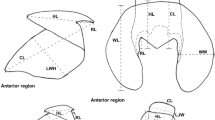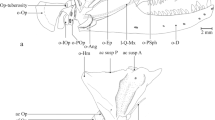Abstract
Morphological and morphometric development of the upper jaw (UJ) and lower jaw (LJ) and arm crown of Chiroteuthis cf. veranyi, Liocranchia reinhardti (oceanic species), and Doryteuthis opalescens (neritic species) paralarvae were analyzed in order to verify whether or not they are determined by developmental modes. Jaw measurements were taken, correlated with mantle length (ML) by multiple linear regression to determine relative influences on growth, and compared between species by ANOVA to identify differences. Development was expected to be similar between oceanic species, but was morphologically similar between L. reinhardti and D. opalescens, and morphometrically similar between the latter and C. cf. veranyi. UJ and LJ measurements with highest correlation with ML are larger in L. reinhardti, indicating greater beak development in this species. Rostrum robustness is higher in L. reinhardti, intermediate in D. opalescens, and lower in C. cf. veranyi, hinting at the respective prey type. Teeth (LJ) and slit, characteristics of ancestral cephalopods, are present, disappearing completely and partially on the largest specimens of L. reinhardti and D. opalescens, respectively, and remaining in all sizes of C. cf. veranyi. The results suggest that their presence in early paralarvae reflects an adaptation to sucking the pre-digested internal fluids of prey.










Similar content being viewed by others
References
Arkhipkin, A., 1996. Age and growth of planktonic squids Cranchia scabra and Liocranchia reinhardti (Cephalopoda, Cranchiidae) in epipelagic waters of the central-east Atlantic. Journal of Plankton Research 18: 1675–1683.
Arkhipkin, A. I., Y. N. Zheronkin, Y. A. Loktionov & A. S. Schetinnikov, 1988. Fauna and distribution of pelagic cephalopods larvae in the Gulf of Guinea. Zoologichesky Zhurnal 67: 1459–1468.
Boletzky, S. V., 1971. Mandibules denticulées chez les larves des Teuthoidés et des Octopodes (Mollusca, Cephalopoda). Comptes Rendus de l’Académie des Sciences Paris, Série D 272: 2904–2906.
Boletzky, S. V., 1974. The “larvae” of Cephalopoda: a review. Thalassia Jugoslavica 10: 45–76.
Boucaud-Camou, E. & R. Boucher-Rodoni, 1983. Feeding and digestion in cephalopods. In Saleuddin, A. S. M. & K. M. Wilbur (eds), The Mollusca, Vol 5: Physiology. Part 2. Academic Press, New York: 149–187.
Castro, J. J. & V. Hernández-García, 1995. Ontogenetic changes in mouth structures, foraging behaviour and habitat use of Scomber japonicus and Illex coindetti. Scientia Marina 59: 347–355.
Cherel, Y. & K. A. Hobson, 2007. Geographical variation in carbon stable isotope signatures of marine predators: a tool to investigate their foraging areas in the Southern Ocean. Marine Ecology Progress Series 329: 281–287.
Cherel, Y., L. Kernaléguen, P. Richard & C. Guinet, 2009. Whisker isotopic signature depicts migration patterns and multi-year intra- and inter-individual foraging strategies in fur seals. Biology Letters 5: 830–832.
Clarke, M. R., 1986. A Handbook for the Identification of Cephalopod Beaks. Clarendon Press, Oxford.
Forsythe, J. W., 1993. A working hypothesis on how seasonal temperature change may impact the field of growth of young cephalopods. In Okutani, T., R. K. O’Dor & T. Kubodera (eds), Recent Advances in Cephalopod Fisheries Biology. Tokai University Press, Tokyo: 133–143.
Franco-Santos, R. M., J. Iglesias, P. M. Domingues & E. A. G. Vidal, in press. Early beak development in Argonauta nodosa and Octopus vulgaris (Cephalopoda: Incirrata) paralarvae suggests adaptation to different feeding mechanisms. Hydrobiologia. doi:10.1007/s10750-013-1721-4.
Harman, R. F. & R. E. Young, 1985. The larvae of Ommastrephid squids (Cephalopoda, Teuthoidea) from Hawaiian waters. Vie et Milieu 35: 211–222.
Hernández-García, V., A. M. Martin & J. J. Castro, 2000. Evidence of external digestion of crustaceans in Octopus vulgaris paralarvae. Journal of the Marine Biological Association of the UK 80: 559–560.
Hernández-García, V., U. Piatkowski & M. R. Clarke, 1998. Development of the darkening of Todarodes sagittatus beaks and its relation to growth and reproduction. South African Journal of Marine Science 20: 363–373.
Ihaka, R. & R. Gentleman, 1993. R (Version 2.13.0) [software]. http://cran-r.c3sl.ufpr.br/.
Jackson, G. D., 1994. Statolith age estimates of the loliginid squid Loligo opalescens (Mollusca: Cephalopoda): corroboration with culture data. Bulletin of Marine Science 54: 554–557.
Jereb, P. & C. F. E. Roper, 2010. Cephalopods of the world. An annotated and illustrated catalogue of cephalopod species known to date. Vol. 2, Myopsid and Oegopsid squids. FAO Species Catalogue for Fishery Purposes. FAO, Rome.
Karpov, K. A. & G. M. Cailliet, 1979. Prey composition of the market squid, Loligo opalescens Berry, in relation to depth and location of capture, size of squid, and sex of spawning squid. CalCOFI Report, Vol. 20.
Kasugai, T., S. Shigeno & Y. Ikeda, 2004. Feeding and external digestion in the Japanese pigmy squid Idiosepius paradoxus (Cephalopoda: Idiosepiidae). Journal of Molluscan Studies 70: 231–236.
Koslow, J. A. & C. Allen, 2011. The influence of the oceanic environment on the abundance of market squid, Doryteuthis (Loligo) opalescens, paralarvae in the Southern California Bight. CalCOFI Report, Vol. 52.
Lehmann, U., 1981. Ammonite jaw apparatus and soft parts. In House, M. R. & J. R. Senior (eds), The Ammonoidea, Systematics Association Special Volume 18. Academic Press, London: 275–287.
Nesis, K. N., 1987. Cephalopods of the World. T. F. H. Publications Inc., New Jersey.
Nesis, K. N., 1999. Cephalopoda. In Boltovskoy, D. (ed.), South Atlantic zooplankton, Vol. I. Backhuys Publishers, Leiden: 707–795.
Nixon, M. & K. Mangold, 1996. The early life of Octopus vulgaris (Cephalopoda: Octopodidae) in the plankton and at settlement: a change in lifestyle. Journal of Zoology 239: 301–327.
Nixon, M. & J. Z. Young, 2003. The Brains and Lives of Cephalopods. Oxford University Press, United Kingdom.
Passarella, K. C. & T. L. Hopkins, 1991. Species composition and food habits of the micronektonic cephalopod assemblage in the eastern Gulf of Mexico. Bulletin of Marine Science 49: 638–659.
Rasband, W. S., 1997. Image J (Version 1.46) [software]. National Institutes of Health (NIH), Maryland, USA. http://rsbweb.nih.gov/ij/download.html.
Raya, C. P. & C. L. Hernández-González, 1998. Growth lines within the beak microstructure of the octopus Octopus vulgaris Cuvier, 1797. South African Journal of Marine Science 20: 135–142.
Roper, C. F. E. & M. L. Sweeney, 1992. Chiroteuthidae. In Sweeney, M. J., C. F. E. Roper, K. M. Mangold, M. R. Clarke & S. V. Boletzky (eds), “Larval” and Juvenile Cephalopods: A Manual for Their Identification. Smithsonian Institution Press, Washington, DC: 171–175.
Roper, C. F. E. & R. E. Young, 1975. Vertical Distribution of Pelagic Cephalopods. Smithsonian Institution Press, Washington, DC.
Roper, C. F. E., M. L. Sweeney & C. E. Nauen, 1984. FAO species catalogue. Cephalopods of the world, Vol. 3. An annotated and illustrated catalogue of species of interest to fisheries. FAO Fisheries Synopsis, Rome.
Shigeno, S., H. Kidokoro, T. Goto, T. Tsuchiya & S. Segawa, 2001. Early ontogeny of the Japanese common squid Todarodes pacificus (Cephalopoda, Ommastrephidae) with special reference to its characteristic morphology and ecological significance. Zoological Science 18: 1011–1026.
Tanabe, K. & N. H. Landman, 2002. Morphological diversity of the jaws of cretaceous Ammonoidea. Abhandlungen der Geologischen Bundesanstalt 57: 157–165.
Uchikawa, K., M. Sakai, T. Wakabayashi & T. Ichii, 2009. The relation between paralarval feeding and morphological changes in the proboscis and beaks of the neon flying squid Ommastrephes bartramii. Fisheries Science 75: 317–323.
Uyeno, T. A. & W. M. Kier, 2007. Electromyography of the buccal musculature of octopus (Octopus bimaculoides): a test of the function of the muscle articulation in support and movement. The Journal of Experimental Biology 210: 118–128.
Vecchione, M., 1998. Ontogenetic characters and cephalopod systematics. In Voss, N. A., M. Vecchione, R. B. Toll & M. J. Sweeney (eds), Systematics and Biogeography of Cephalopods, Vol. 1. Smithsonian Institution Press, Washington, DC: 11–20.
Vidal, E. A. G., F. P. DiMarco, J. H. Wormuth & P. G. Lee, 2002a. Optimizing rearing conditions of hatchling loliginid squid. Marine Biology 140: 117–127.
Vidal, E. A. G., F. P. DiMarco, J. H. Wormuth & P. G. Lee, 2002b. Influence of temperature and food availability on survival, growth and yolk utilization in hatchling squid. Bulletin of Marine Science 71: 915–931.
Vidal, E. A. G., F. P. DiMarco & P. G. Lee, 2006. Effects of starvation and recovery on the survival, growth and RNA/DNA ratio in loliginid squid paralarvae. Aquaculture 260: 94–105.
Wakabayashi, T., K. Saito, K. Tsuchiya & S. Segawa, 2002. Descriptions of Eucleoteuthis luminosa (Sasaki, 1915) and Ornithoteuthis volatilis (Sasaki, 1915) paralarvae in the northwestern Pacific. Venus 60: 237–260.
Wakabayashi, T., K. Tsuchiya & S. Segawa, 2005. Morphological changes with growth in the paralarvae of the diamondback squid Thysanoteuthis rhombus Troschel, 1857. Phuket Marine Biological Center Research Bulletin 66: 167–174.
Young, R. E., 1991. Chiroteuthid and related paralarvae from Hawaiian waters. Bulletin of Marine Science 49: 162–185.
Young, R. E. & C. F. E. Roper, 1998. Chiroteuthidae Gray, 1849. Tree of Life web project. http://tolweb.org/Chiroteuthidae/19451/1998.01.01. Accessed on November 11th, 2012.
Young, R. E., R. F. Harman & K. M. Mangold, 1985. The eggs and larvae of Brachioteuthis sp. (Cephalopoda: Teuthoidea) from Hawaiian waters. Vie et Milieu 35: 203–209.
Zar, J. H., 1984. Biostatistical Analysis. Prentice-Hall, Englewood Cliffs.
Zeidberg, L. D. & W. M. Hamner, 2002. Distribution of squid paralarvae, Loligo opalescens (Cephalopoda: Myopsida), in the Southern California Bight in the three years following the 1997–1998 El Niño. Marine Biology 141: 111–122.
Acknowledgments
We kindly thank Dr. Maurício Garcia de Camargo for providing advice on statistical analyses, Dr. Manuel Haimovici for providing some of the paralarvae used in this study, and two anonymous reviewers for very thorough corrections and useful suggestions. This work was conducted in partial fulfillment of a M.Sc. degree by RMF-S, who was supported by a graduate scholarship from the Brazilian “Coordenação de Aperfeiçoamento de Pessoal de Nível Superior” (CAPES). EAGV was supported by the Brazilian National Research Council-CNPq (Pro 307204/2011-1).
Conflict of interest
The authors declare that they have no conflict of interest.
Ethical standards
The experiments described in the present study comply with the current laws of the country in which they were performed.
Author information
Authors and Affiliations
Corresponding author
Additional information
Guest editors: Erica A. G. Vidal, Mike Vecchione & Sigurd von Boletzky / Cephalopod Life History, Ecology and Evolution
Rights and permissions
About this article
Cite this article
Franco-Santos, R.M., Vidal, E.A.G. Beak development of early squid paralarvae (Cephalopoda: Teuthoidea) may reflect an adaptation to a specialized feeding mode. Hydrobiologia 725, 85–103 (2014). https://doi.org/10.1007/s10750-013-1715-2
Received:
Accepted:
Published:
Issue Date:
DOI: https://doi.org/10.1007/s10750-013-1715-2




